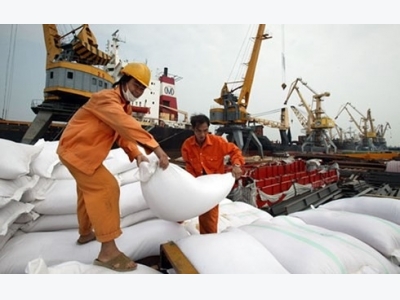Việt Nam expects to export 6.5 million tonnes of rice in 2018

The Ministry of Agriculture and Rural Development expects Việt Nam to export 6.5 million tonnes of rice in 2018. – Photo cafef
HÀ NỘI – The Ministry of Agriculture and Rural Development expects Việt Nam to export 6.5 million tonnes of rice in 2018, Deputy Minister of Agriculture and Rural Development Hà Công Tuấn said at the ministry’s monthly meeting on Friday in Hà Nội.
To get high export value, high-quality rice will still account for a large proportion of the total export volume, while normal rice makes up less than 20 per cent, Tuấn said.
He also said the export prices of Vietnamese rice had increased as their quality had improved.
The export price of Vietnamese rice rose from US$435 per tonne in 2016 to $450 per tonne in 2017 and $475 per tonne during the January-February period.
This was achieved by restructuring efficiently the production of rice to improve its quality and value.
At the same time, in the past two years, more local private enterprises have joined the global export market. Businesses have also invested more into the processing of rice but the percentage of processed rice is still low.
Việt Nam is doing well to improve its rice quality, he said, suggesting the country focus on improving the brand name of its rice.
According to the Ministry of Agriculture and Rural Development, Việt Nam shipped 861,000 tonnes of rice abroad in the first two months of this year, earning $419 million, up 17 per cent in volume and 34 per cent in value, compared with the same period last year.
The Philippines was the biggest importer of Vietnamese rice, accounting for 26.9 per cent of the market share. It was followed by China with 23.5 per cent.
Last year, Việt Nam earned $2.6 billion by exporting 5.8 million tonnes of rice.
Related news
 Fruit, vegetable exports continue growth trend in two months
Fruit, vegetable exports continue growth trend in two months Vietnam exported 293,960 tonnes of fruits and vegetables worth 620 million USD in the first two months of 2018, a year-on-year rise of 47% and 47.6%
 Export value of fruit and vegetables increases
Export value of fruit and vegetables increases The main fruits exported from Vietnam are dragon fruit, longan, mango, durian, and watermelon, with market shares of 37%, 22%, 8%, 7%, 5%, respectively.
 Potential for organic production in EU continued to rise
Potential for organic production in EU continued to rise Organic production area is divided into three main crop types: arable land crops (mainly cereals, fresh vegetables, green fodder and industrial crops)